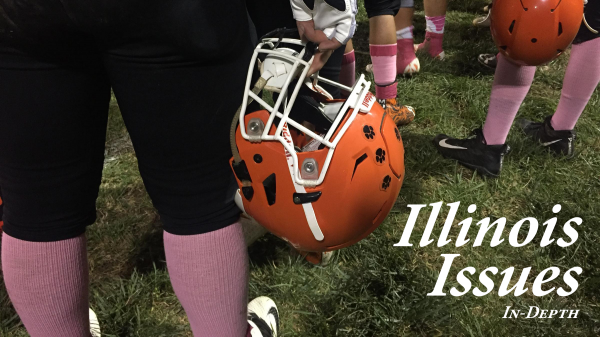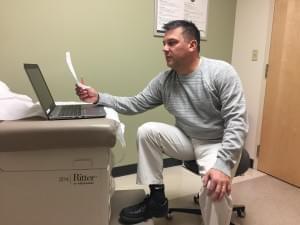Is State Concussion Law A Level Playing Field For All Schools?

Football players from Greenfield and Northwestern high schools stand on the field at a game in October. Jaclyn Driscoll/NPR Illinois
During a water polo match two years ago, Katie Price took an elbow to her right eye. She says she immediately knew something was wrong. “I realized I’d gotten hit, and I was yelling for my coach,” says the 17-year-old. She instantly began to cry, not just because of the pain that set in, but the shock of the entire ordeal. A doctor confirmed she had suffered a concussion.
Memory loss is one of many side effects she has dealt with since her injury freshman year at Metea Valley High School in Aurora.
“Most people can remember very basic things,” says Katie. “I can’t.”
Lori Price, Katie’s mother, wasn’t initially that concerned by her daughter’s diagnosis. She thought it would take about a week before her daughter healed. But Katie’s injury was severe. It not only ended her athletic career, it also strained her academic performance.
“She’s not getting the grades she used to get,” Lori says. “She’s still doing really well, but she has to work really hard for that.”
Reported head injuries in high school sports are on the rise in Illinois, according to numbers from the Illinois High School Association (IHSA). The steady increase means coaches and athletic trainers are recognizing more injuries and keeping students from returning to play, say sports medicine experts.

Katie Price sits with her mom, Lori, at their home in Aurora. Katie suffered a concussion her freshman year while playing water polo. The 17-year-old has since had four more.
Recent state-required protocols for head injuries for all athletic programs and better education about the dangers of concussions have improved reporting, according to these experts. Under a 2015 state law, high schools must convene a team to develop "return-to-play" and "return-to-learn" procedures for students who have suffered a concussion. But without any funding behind the law, some worry smaller schools don’t have the resources to put in place procedures that protect student-athletes.
Since 2010, there have been 2,029 head injuries reported during sporting events statewide, according to IHSA. While the data doesn’t track how serious each injury was, it does show that in more than three-quarters of those incidents, the athlete was not allowed to return to that specific game or contest.
Kurt Gibson, the associate executive director of the IHSA, says that both coaches and athletes have a much better understanding of head injuries now and the consequences of trying to play through them.
“I think in the last 10 years there’s been a lot of medical research put out that has enabled groups to learn more about what a concussion is,” says Gibson. “Maybe it’s safe to say the definition of what is a concussion has changed and changed dramatically.”
Dr. Brett Western, a sports medicine specialist at Springfield Clinic, says he treats many athletes with concussions throughout central Illinois. Western echoes the IHSA’s conclusion that recognition of head injuries has improved.
“[The legislation] has increased the numbers for sure,” says Western. “Coaches, trainers and officials are recognizing them, and these kids can’t return to play.”
Staying out of the game lessens their chances of getting a second concussion before the first one has healed, a condition called second-impact syndrome (SIS). The syndrome can cause serious injury or even death.
Guidelines for how and when a student-athlete who’s had a head injury can get back in the game – "return-to-play" procedures – are a critical component of Illinois’ concussion management law. Physicians, athletic trainers, advanced practice nurses and physician assistants are now the only health care providers who can clear an athlete to return to play. Typically, there is a lengthy physical test that athletes must complete before receiving clearance. The checklist that Springfield Clinic uses shows five stages of physical exertion that each athlete must be able to complete.

Dr. Brett Western, a sports medicine specialist at Springfield Clinic, says his team has had 160 visits from patients with concussions or concussion symptoms since the beginning of the school year.
The concussion law also lays out rules for a "return-to-learn" process, or steps for athletes integrating back into classroom work. Each school district must establish accommodations needed after a concussion. Since concussion symptoms vary, the procedures are individualized.
Concussions are typically caused by a blow to the head, which is why contact sports see a larger number of athletes sustaining concussions.
“Particularly [in] the fall, they're most common because of football,” says Western. “But also soccer goes on in the fall, and there’s quite a few from that, too.”
Since the 2017 school year began, Western’s medical team has had 160 visits from patients with concussions or concussion symptoms. “Any given day we’re probably seeing two to three kids,” he says.
About a year into implementing Illinois’ concussion management legislation, there is still a high number of athletes sustaining head injuries. Rep. Stephanie Kifowit, a sponsor of the legislation, says the law is more about education. “It’s to look at our sports and try to minimize concussions,” says Kifowit, a Democrat from Oswego. “But I think it’s also to raise awareness.”
Education is a key component of the law. Each school district is required to use material provided by the IHSA to make sure coaches, athletes and their parents understand the risk of head injury and the potential danger each sport can pose.
The legislation lays out rules for each response team, the concussion oversight team. But since there are no funds available to assist districts, the rules can turn out to be more like guidelines. For example, the bill states that the team must include a physician, but only if it’s affordable. The bill lays out other options, such as including an athletic trainer or a school nurse, but again, only if each district has the funds available. For smaller districts without resources, they are simply required to appoint a person to be in charge, which may put their student-athletes at a disadvantage.
“There’s lots of smaller schools that don’t have access,” says Western. “We see the vast majority of our concussion kids from schools we have athletic trainers at. I don’t think that’s because they’re the only schools that have concussions. I think it’s because those are the schools where we have trained professionals picking them up.”
Many smaller schools like Northwestern High School in Palmyra, Illinois, do not have an athletic trainer on staff because they cannot afford it. As a part of the Western Illinois Valley Conference, the school of just under 100 students partners with Passavant Hospital in Jacksonville, which provides an athletic trainer at no cost. The trainer attends football games since there is a greater risk of injury, but not any other sporting event. The trainer also provides free checkups at the school roughly once each week for student-athletes who may have been injured.
Athletic Director Nick Troutwine says this is an excellent service for students. Many from low-income households might not be able to afford going to a hospital or sports clinic. “It’s nice for the kids because now they don’t have to travel somewhere. If they had to pay for it out of pocket, I just think they wouldn’t go.”
Troutwine says that not being able to staff a trainer does put their school at a disadvantage though. Since a trainer isn't present at every athletic event, if a student suffers a head injury, it typically means he or she will have to sit out the rest of the game. That puts additional stress on the coaching staff and administration to make game-time decisions they could be liable for.

State Rep. Stephanie Kifowit, an Oswego Democrat, sponsored legislation aimed at reducing head injuries in high school sports. Kifowit (center) sits with Katie and Lori Price in Aurora, Illinois. Katie has suffered five concussions.
Kifowit says the law could be more effective with funding assistance, especially for smaller districts that may not have the means to hire trained professionals. But with the current state of education funding in Illinois, it just isn’t possible right now.
Still, many coaches throughout Illinois say the law is, at the very least, making sure everyone understands the risk associated with athletics and head injuries. Springfield High School head football coach Roy Gully says the legislation changed the way his team operates, both on and off the field.
“We have two parent meetings, one at the beginning of summer and one right before the season starts,” Gully says. “One of the main reasons we hold two parent meetings is so I can get with them twice to communicate our injury protocol.”
Like many football coaches across the state, Gully is battling declining participation numbers.
Gully believes that parents have a fear of the game, and rightfully so as more studies show a link between the degenerative brain disease chronic traumatic encephalopathy (CTE) and professional football players. That includes a recent study published in the medical journal JAMA that found CTE in 110 deceased NFL players out of the 111 studied.
“Hearing now [about] former players from 20, 30, 40, 50 years ago talk about horrible circumstances where people were injured, but were coaxed to go in and play through those things, and now they have long-term injuries,” Gully says, has influenced parents.
However, Gully says the game has changed. There’s better equipment, more education and stricter injury protocols. He believes those CTE numbers just won’t be the same in the future. “Now we know what happens when you continue to [not treat] concussions,” he says. “Don’t label all football as dangerous.”

Practice field at Glenwood High School in Chatham, Illinois.
As a coach and proponent of safe football, Gully says he still understands that the game can be dangerous. When his now 10-year-old son was playing in a junior football league, Gully learned the coaches were still conducting the Oklahoma drill, a controversial football technique where players face each other one-on-one in full contact situations. His son was in fourth grade at the time. “He was going up against sixth-graders in some cases,” which could be a significant difference in weight and height, risking serious injury. As a parent, Gully gave his son the option to continue to play the following year. “He did not play in fifth grade.”
It’s not just football. “There’s an inherent risk of injury in all sports,” says Gibson of the IHSA. Parents and student-athletes must weigh the risk of injury with a desire to participate in athletics.
That’s something Katie Price and her family know all too well. Although Katie developed a love for water polo, which her mother says could have earned her a college athletic scholarship, her daughter’s health is the top priority.
Katie did try to return to swimming her sophomore year after her first concussion. Since it wasn’t a contact sport like water polo, the Price family assumed she would be safe. Katie found that she was still getting dizzy and nauseated after competition even months after she took that blow to her eye. They soon learned that the flip turns were causing too much strain on Katie’s brain, which they now believe wasn’t completely healed despite getting an all-clear from a doctor. Also, during a meet, Katie was kicked in the head by another swimmer, resulting in another concussion diagnosis for the teen in less than six months.
Katie has since suffered three additional concussions, not related to athletics. “This is like an invisible disability,” says Lori, Katie’s mom. The family is constantly worried about Katie hitting her head in any way. They believe she is now more susceptible to concussions, which medical experts say is a possibility.
“There’s some debate about that,” says Western. “Most of the time those who seem to be more prone to concussions, [it] is generally because their first one didn’t resolve. But, there’s also evidence that after having injuries you certainly can be more prone to it, and I’ve seen that as well.”
As a senior, Katie still receives academic assistance because of her concussions, thanks to the return-to-learn components in Illinois’ concussion legislation. Her teachers will allow her extra time on homework assignments or let tests be broken up and taken at different times. She’s even including her injuries on her college applications.
“In the part of the application that says tell us about anything else that may have affected your academic learning, we include that in there,” says Lori. Once they decide what college Katie will go to, they plan to meet with academic advisors to develop a learning plan suitable for the teen.

Katie loves sports and competition, but she’s learned how dangerous they can be. She won’t compete again and says her experiences are something she will carry with her forever, especially when she becomes a parent. “When I have kids, I will be really cautious of them playing sports because I don’t want them to go through what I go through.”
Illinois Issues is in-depth reporting and analysis that takes you beyond the headlines to provide a deeper understanding of our state. Illinois Issues is produced by NPR Illinois in Springfield.
Links
- Illinois Issues: Is The State Budget Balanced?
- Illinois Issues: Cities Lose Out On Retail Tax As Online Shopping Booms
- Illinois Issues: Land of Lincoln, New Jersey Compete For Worst Fiscal Condition
- Illinois Issues: Worry About DACA’s Fate Triggers Anxiety, Depression In Immigrants
- Illinois Issues: Coming Up In The Veto Session
- Illinois Issues: We Have Met The Enemy And He Is Us
- Illinois Issues: A Master Of Compromise Exits
- Illinois Issues: The Man With The Education Reform Mission
- Illinois Issues: No Money For Shoes
- Illinois Issues: Flat Vs. Graduated Income Tax
